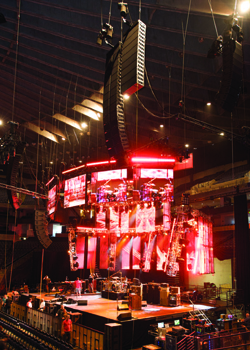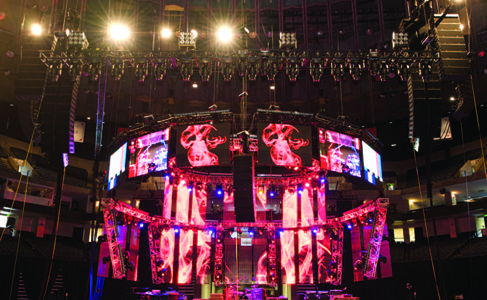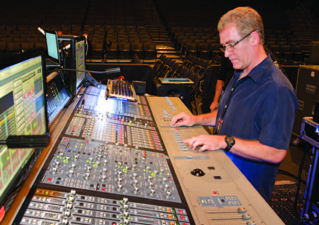
“If I want to get into multi-band compression, I typically use an MC2000 on Tom’s vocal and bass guitar,” he notes.
“Our vocal chain is essentially the multiband compression along with some dynamic equalization to take care of things down in the low-mids and some of the ‘esses’.”
“That’s really about it. After that it’s just onboard compression and EQ as needed.”
Crane Song Phoenix tape head emulation plug-ins are applied on specific inputs as well as right across the mix bus.
Eventide reverb is a primary player on the drum kit, which also benefits from Waves API 2500 compression.
As further complement, a Brainworx BX Boom plug-in sees use on the drum kit in a fashion similar to a low frequency harmonics box.
Different Directions
It’s been a long time since Scovill first came to rehearsals and found Petty singing into an Shure SM57 with no windscreen, surrounded by four wedges.
With little to no wireless historically being the norm for Petty and The Heartbreakers, this tour is no exception. Petty’s vocal mic these days is a Neumann KMS 150.
“Compared to other singers, Tom is pretty quiet,” he relates, “and his singing has consonants that are often rounded-off. Because of the gain before feedback challenges for live events, it was often very challenging to get a lot of diction on his microphone.
That’s why I took a turn in a completely different direction from what I came upon, and suggested the most sensitive mic I could find in the midrange.
“The KMS 150 is certainly that, with the caveat that it also has a very wide pickup pattern, so you have to be very aggressive and in total control of that fader for the entire night.”
“You cannot leave it on when he steps away from the mic, so as a mixer you have to learn all of his moves and really be on your toes.”
For past tours, for the sake of continuity, the KMS 150 was also the preferred microphone for backing vocals.
Based on the results of a shoot-out among other mics prior to this tour, however, Heil Sound PR35 microphones landed the job this time for sonic reasons and also because they’re tight in regard to surrounding noise. Back on the drum kit, Scovill employs a Rode NT4 cardioid condenser stereo mic.
“The top end of NT4 is shut down a little compared to most other condensers,” Scovill says of the X/Y device, “but I really like its midrange and low-mids. Plus it lets me easily get a stereo mic up in one position and have very consistent placement night-to-night. I love the center image, it’s a big part of my snare and tom sound up front.”
The Next Level
Onstage, monitor world receives direction and guidance from Greg Looper, part of a crew that also includes crew chief John “Haircut” Tompkins, assistant house engineer Jim Brentlinger, assistant monitor engineer Mike Bangs, and tech Mike Murante.
Keeping with a Petty dictum that says if it ain’t broke don’t fix it, the task of monitoring still relies on a proprietary wedge design first developed by touring company Electrotec years ago.
On the flip side, the stage mix, like the house, jumps into the 21st century thanks to the addition of a second D-Show VENUE desk.
Having pared the number of wedges down over the decades, Petty uses a single in-ear monitor as a supplement to a mix supplied by his own single wedge. Four more wedges span across the stage, and there are no side fills.
At the request of Scovill, Sound Image took delivery of the L-Acoustics K Standard package to serve the tour, comprised of 48 K1 and 36 KUDO enclosures, 24 K1-SB and 24 SB28 subs.


